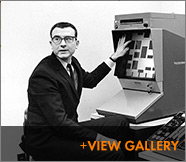Political Scientist Kenneth Janda
Computing Early and Often
Ken Janda was one of the first Northwestern professors to incorporate computers extensively into his classroom teaching. Janda, now Payson S. Wild Professor Emeritus of political science, remembers a class project in 1962, his first year at Northwestern. In the general election for representative from what was then the 13th congressional district in Illinois, a battle was brewing between a relatively unknown candidate, Donald Rumsfeld, and John A. Kennedy, no relation to the recently-elected U.S. President John F. Kennedy.
“In my course on public opinion and voting behavior,” says Janda, “I had my students conduct a survey all over the 13th district, as far as Barrington. We interviewed 339 people on a random sample basis, asking their voting preferences. Then students punched out all the data on cards and fed them into an IBM 709 computer in the basement of the Technological Institute. They made their analyses on an elementary program that produced cross-tabulations of variables, in this case, voting preference by party identification. We did the only survey of the election and the results were printed in the Tribune and Sun-Times.” The students’ prediction that Rumsfeld would win 59.2 percent of the vote to Kennedy’s 40.8 percent was prescient: Rumsfeld actually received 63.5 percent.
Janda adds as a footnote that teachers could not assign such a survey today because of university liability for students’ safety.
Another memorable project concerned presidents and religion. Laura Olson, a Janda student in the late ’80s, compiled presidents’ use of religious references in their state of the union addresses. She made a dictionary of terms—“faith,” “sacred,” “God,” and “religion”—and applied them to all the addresses from Harry Truman through Ronald Reagan. Working on a mainframe in the Vogelback Computing Center, Olson analyzed the data using a textual information retrieval and analysis program written at Northwestern called RIQS (Remote Information Query System).
The findings were startling. Presidents Truman, Eisenhower, Kennedy, Johnson, Carter, and Ford had all used the terms on an average of once per thousand words. Reagan, however, used the terms six times as often.
“Reagan was, after all, the president who started saying, ‘Good night and God bless America,’” says Janda. “Truman had said merely, ‘Thank you and good night.’
“It was an outstanding paper and an outstanding finding,” says Janda of his former student’s work. Olson’s experience in his class led her to forgo a career in law for an eventual professorship in political science at Clemson University.
Janda issues a challenge to today’s students to use the computer more fully as a tool for original research—not just to write papers, play games, and access Facebook.
Note: Janda is the author of a college textbook on American government, The Challenge of Democracy, written with Jerry Goldman and Jeff Berry, and co-editor of the international journal Party Politics. He and Goldman also created IDEAlog, an award-winning application for analyzing political values.
Back to top